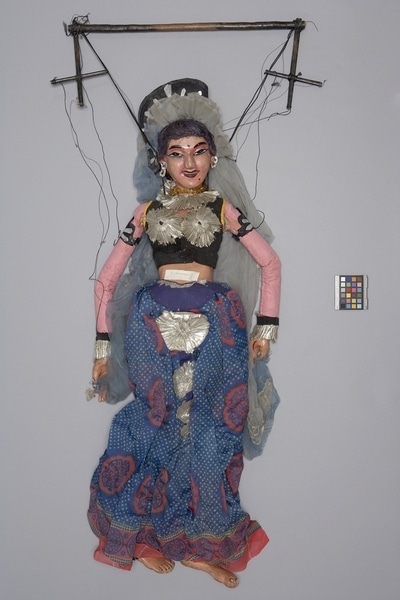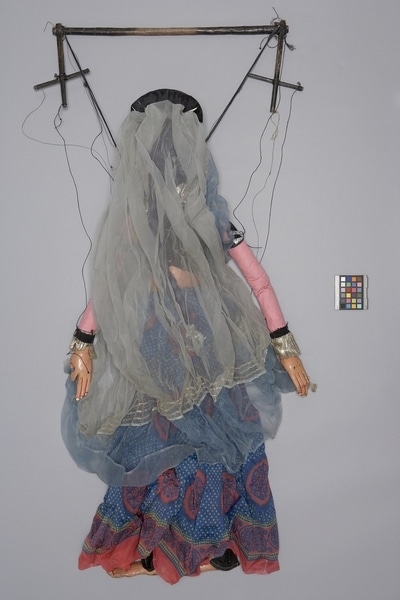String Puppet Item Number: Eh164 a-b from the MOA: University of British Columbia


Description
Three-dimensional female humanoid puppet (Tamil dancer character): head with headdress (part b) fits into body clothed in a skirt and shirt (part a). The body has jointed arms and legs. Headdress is black with geometric shapes of silver foil paper pressed onto the surface; blue and grey gauzy material is gathered at the front of the headdress and trails from the back. The figure is clothed in a midriff-baring black vest with pink sleeves; silver metallic material covers the breasts and forms a sort of neck ruff. The skirt is a full- length, multicoloured garment with a purple v-shaped panel and three circular appliqués made form silver metallic material at the front. Figure's face is a rosy pink colour with red lips, black eyebrows, a black bindi and a black beauty mark on the chin; figure wears dangling earrings of white beads and silver foil. Hair is purple dyed plant fibre tied into a long braid at the back. The index finger and thumb on both hands are joined in a circle and attached to the trailing ends of the gauzy material cascading from the back of the headdress. Feet are bare with white toenails. Puppet is attached to thin black cords tied to wooden sticks.
History Of Use
Lifelike in appearance, the striking rukada (string puppets) of Sri Lanka perform stories about ritual practices and everyday life. There is no scripted play, the puppeteers improvise in their storytelling. The characters, in dress, gesture, and action, express social hierarchies and gender roles: the king and the prince; the politician and the village headman; the policeman and the servant boy; and a family of farmers. There are also character archetypes such as the sanmi (disease) demon dancer, emaciated beggar with elephantiasis, and jesters in colourful costumes who comically announce the beginning and end of the show (from Shadows, Strings & Other Things, 2019).
Item History
- Made in Galle, Sri Lanka during 1950
- Collected during 1983
- Owned by Jason Schoonover before January 31, 1984
- Received from Museum of Anthropology Shop Volunteers (Funding source) and Jason Schoonover (Seller) on January 31, 1984
What
Who
- Culture
- Sinhalese
- Previous Owner
- Jason Schoonover
- Received from
- Museum of Anthropology Shop Volunteers (Funding source) and Jason Schoonover (Seller)
Where
- Holding Institution
- MOA: University of British Columbia
- Made in
- Galle, Sri Lanka
When
- Creation Date
- during 1950
- Collection Date
- during 1983
- Ownership Date
- before January 31, 1984
- Acquisition Date
- on January 31, 1984
Other
- Condition
- fair
- Accession Number
- 0943/0022